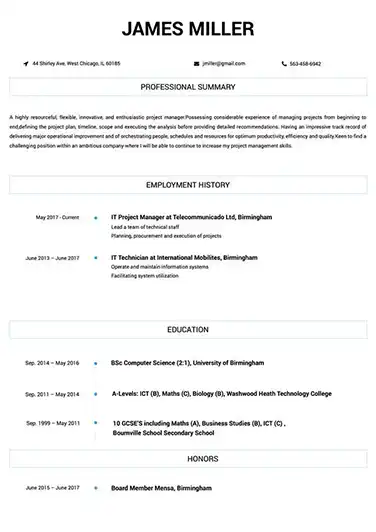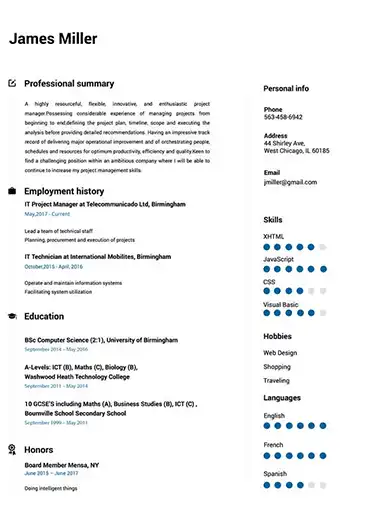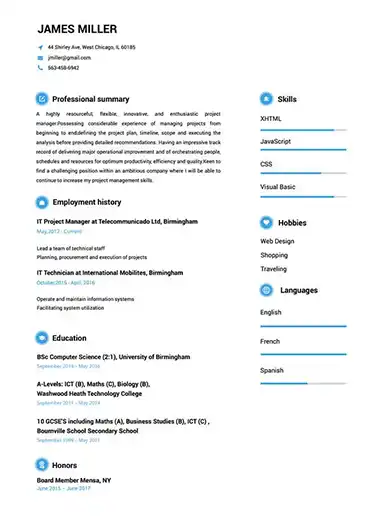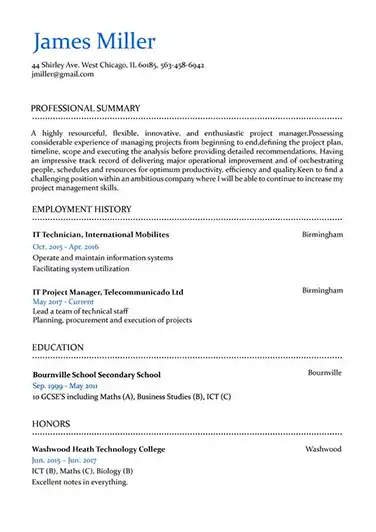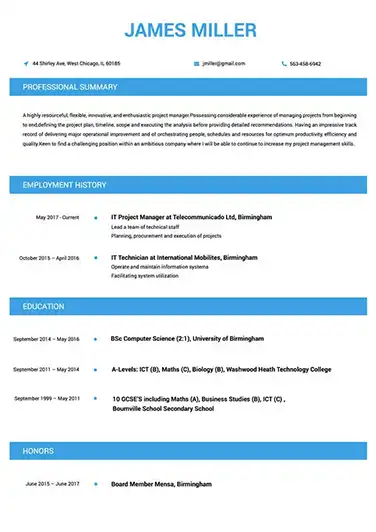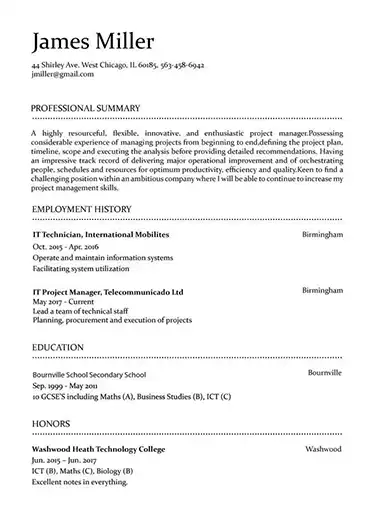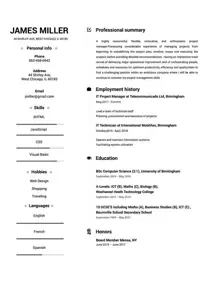 Use This Template
Use This Template
Build your resume in 15 minutes
Create an awesome resume that meets the expectations of potential employers with our selection of professional, field-tested resume templates.
interior designer: Resume Samples & Writing Guide
abe-adams@mail.com
955-533-7614
Employment history
- Develop and implement design concepts that are consistent with client objectives and requirements
- Develop and maintain relationships with suppliers and vendors
- Research and select materials, furnishings, colors, and other items to create desired design effects
- Monitor the progress of projects and ensure that they are completed within budget and on schedule
- Provide technical support and advice to clients
- Develop and implement design concepts that are consistent with client objectives and requirements
- Ensure that all design work complies with applicable building codes and safety regulations
- Create presentations to present design ideas to clients
- Research and select materials, furnishings, colors, and other items to create desired design effects
Education
Skills
Do you already have a resume? Use our PDF converter and edit your resume.
taylorsam13@mail.com
674-650-0435
Employment history
- Develop and implement design concepts that are consistent with client objectives and requirements
- Create sketches, renderings, and other visuals to communicate design ideas
- Develop and maintain relationships with suppliers and vendors
- Collaborate closely with clients, contractors, architects, and other professionals to ensure that the design meets their expectations
- Research and select materials, furnishings, colors, and other items to create desired design effects
- Create sketches, renderings, and other visuals to communicate design ideas
- Stay up-to-date on the latest trends in interior design, materials, and products
- Create sketches, renderings, and other visuals to communicate design ideas
- Monitor the progress of projects and ensure that they are completed within budget and on schedule
Education
Skills
kennydavis@hotmail.com
951-592-0709
Professional Summary
Employment history
- Collaborate closely with clients, contractors, architects, and other professionals to ensure that the design meets their expectations
- Monitor the progress of projects and ensure that they are completed within budget and on schedule
- Create presentations to present design ideas to clients
- Manage budgets and keep track of project costs
- Coordinate with other professionals such as contractors and architects
- Create presentations to present design ideas to clients
- Develop and implement design concepts that are consistent with client objectives and requirements
- Collaborate closely with clients, contractors, architects, and other professionals to ensure that the design meets their expectations
- Prepare detailed drawings, plans, and documents for interior design projects
Education
Skills
ursulafranklin@hotmail.com
965-330-6854
Employment history
- Manage budgets and keep track of project costs
- Prepare detailed drawings, plans, and documents for interior design projects
- Create presentations to present design ideas to clients
- Develop and maintain relationships with suppliers and vendors
- Coordinate with other professionals such as contractors and architects
- Monitor the progress of projects and ensure that they are completed within budget and on schedule
- Prepare detailed drawings, plans, and documents for interior design projects
- Research and select materials, furnishings, colors, and other items to create desired design effects
- Collaborate closely with clients, contractors, architects, and other professionals to ensure that the design meets their expectations
Education
Skills
fostertony@zoho.com
990-003-7429
Employment history
- Research and select materials, furnishings, colors, and other items to create desired design effects
- Manage budgets and keep track of project costs
- Coordinate with other professionals such as contractors and architects
- Provide advice and guidance on the selection of furniture, lighting, flooring, and other elements
- Prepare detailed drawings, plans, and documents for interior design projects
- Monitor the progress of projects and ensure that they are completed within budget and on schedule
- Create presentations to present design ideas to clients
- Prepare detailed drawings, plans, and documents for interior design projects
- Provide technical support and advice to clients
Education
Skills
Not in love with this template? Browse our full library of resume templates
Getting an interior design resume right is about as hard as the toughest client. You’ve got to get the design absolutely perfect, that goes without saying. But you also need to show the artistic side of your work alongside proof that can work with clients, stay on budget, and finish on time.
It’s a lot to juggle, but it’s possible.
This guide will walk you through everything you need to know in order to strike the perfect balance between artistic genius and hard-nosed manager. Read through to the end and you’ll have what it takes to get the commission of a lifetime.
This guide will show you
- Inspirational resume templates to get your creative juices flowing
- How to get your resume past ATS
- How to optimize your resume for the person hiring you
- How an interior designer resume should be formatted
- The proper length for your resume
- Which sections you should consider including
- How to prepare for a job interview
- How to list training and certifications
- Which skills you should include (and how to make them more effective)
- How to list your achievements
- Whether to add an objective or summary (with examples of each)
- What you should do if you have little or no interior design experience
- How to make your resume stand out
- Why a resume builder is a key to success
This is going to be like a major home refresh, so let’s start your resume the same way you’d start any design, by looking at examples.
Resume Template Examples Worthy of an Interior Designer
As an interior designer, you’ve probably created more mood boards than you can count. But chances are - you’ve never approached your resume this way. But as we’ll explain throughout this guide, the key to getting hired is treating your application process the way you’d treat a commission.
That’s why we’re beginning with some expertly-crafted interior design resume template examples. Have a look at them and jot down what you like and don’t (not just about the design, but the content as well).
[Examples]
How to write an interior designer resume that will get you through the door
Now that you’ve got some notes about the design and content you’d like for your resume, let’s get down to business. As mentioned, you need to treat this like a commission and that means studying the client to understand their needs, taste, etc.
After all, you wouldn’t redecorate a home without knowing anything about the people who live there. So how can you create a resume without thinking about who will read it?
Who’s going to read your resume?
There are actually two audiences you need to keep in mind. Crafting an interior designer resume that gets you hired is all about understanding and optimizing for them. So let’s review who they are.
How and why your resume should be ATS-optimized
ATS stands for Applicant Tracking System. These are software algorithms that use artificial intelligence to scan your resume for key information. The idea is to quickly scan large numbers of resumes in order to get rid of the worst ones and to save a human the time.
As an interior designer, your resume is less likely to meet ATS, because they’re used more by larger companies. That said, even many small companies use them so you can never be 100% sure. That’s why even if your clients are usually individuals or small firms, it still pays to ensure your resume is ATS-ready. Here’s what that means:
- Making sure you’re using the right format. ATS are designed to read .pdf, .doc, and .docx files. Sending anything else pretty much guarantees your resume will be rejected. That said, not all .pdfs are created equally.
- Make sure your file’s design is ATS-friendly. As a designer, you may be tempted to create a stunning custom resume in a program like Illustrator. However, even if you can save that as a text rich .pdf file, most ATS are going to have a hard time reading it. That significantly increases the odds your resume gets rejected before a human ever sees that stunning design you created. That’s why it’s best to stick to an ATS-friendly resume builder (more on that below).
- Makes your resume extra easy to scan by matching job ad requirements. ATS use what’s called natural language processing to understand the text on your resume. But this technology is far from perfect and works a bit differently on each of the dozens of ATS tools out there. That’s why you should make it easy by phrasing your skills and experiences as closely to the way they’re written as possible.
Treating the recruiter like a client
Whether your resume will meet an ATS or not, there’s always going to be a person on the other end, who will decide whether to hire you. In this scenario, they’re your client. Their opinion is everything so ignore them at your peril.
One key difference between this client and most others is that you can’t simply ask them what they want. So you’ll need to do a bit of research. Try and gather as much information as you can about the company or client so you can have a grasp of their aesthetic and requirements.
Of course your best source of this information will always be the job ad itself. Treat it like a brief. Your resume should function like a targeted proposal designed to perfectly meet the requirements of the “brief.”
Also consider the fact that the person who reads your resume is just a person. They probably have a lot of resumes to consider and it’s in your interest to make that job easy for them. So make sure your writing is clear (having a friend review it helps) so reading your resume isn’t a chore. If they need to read one sentence three times to understand what you meant, they’re going to get annoyed with you fairly quickly. But you should also consider sticking to a clean design that doesn’t distract from the content. In general, you want to save your design work for your portfolio and keep your resume more straightforward.
The last thing to note here is also that the person reading your resume is probably just as concerned with things other than your interior design style. They will want to know whether you are easy to work with, can finish a project on-time, and can stay within budget. Be sure to include plenty of information about these topics in your resume.
How should you format your resume?
Once you’ve researched your “client” and have some idea about how you want to approach your resume, you need to decide on the format. The first rule of thumb is to make your experience reverse chronological. Your prospective employer doesn’t want to be taken on a journey through your artistic development from your first commission. From their perspective, your most recent work is the most important.
On that note, the other main rule to follow is to put the most important information towards the top. In many cases the person reviewing your resume won’t even read all the way to the bottom. So putting something important down there is a recipe for disaster. So remember: recent and important goes at the top.
How long should your resume be?
Another thing every interior designer crafting a resume has to consider is length. Once again the key is to put yourself in the shoes of the person reviewing your resume. Obviously in most cases they would prefer not to spend the time reviewing several pages. So, if possible, try and limit your resume to a single page (after all, you’re probably including a portfolio that will provide a lot more information about your work).
That said, there are cases when more than one page is warranted. The rule of thumb is that all the information included on your resume should be valuable. You don’t want your resume to be like a room overstuffed with knickknacks and clutter, so don’t overstuff your resume with information that won’t be useful to the reader.
One trick to do this is to look at each piece of information and ask yourself whether it adds value to your resume. If it’s not making your resume better, it’s making it worse and should be removed.
What are the most important sections to include?
For interior designers, these are the sections you’ll want to consider. Just don’t be tempted to include them all, choose the ones which add value to your resume.
- A resume summary or objective
- Work experience
- Hard skills
- Soft skills
- Certifications or training
- Education
- Languages
- Volunteering
- Design styles or inspiration
How to list additional training and certifications as an interior designer
Too many interior designers make the mistake of thinking that their designs alone will bring them work. But clients want more than just good design. They want to feel confident you have the skills to deliver on a project. One of the best ways to demonstrate that (especially if you don’t already have years of practical experience to show off) is with training and certifications.
To list a certification or training, just write the name, followed by the organization granting it and the year you obtained it. It should look like this:
Certified Remodeler Specialist (CRS), National Association of the Remodeling Industry, 2009
The best certifications to include on an interior designer resume
- Lighting certifications like Lighting Associate (LA), Lighting Specialist (LS), Certified Lighting Manufacturers Representative (CLMR), and Certified Lighting Consultant (CLC)
- Council for Interior Design Accreditation (CIDA)
- International WELL Building Institute (IWBI)
- Leadership in Energy and Environmental Design for Interior Design and Construction (LEED ID+C)
- National Association of Homebuilders Certifications like Certified Aging-in-Place Specialist (CAPS), Certified Green Professional™ (CGP), or Certified Graduate Remodeler (CGR)
- National Association of the Remodeling Industry (NARI) certifications like Certified Remodeler (CR), Certified Remodeler Specialist (CRS), Certified Remodeler Associate (CRA), Master Certified Remodeler (MCR), Certified Kitchen and Bath Remodeler (CKBR), Certified Lead Carpenter (CLC), Certified Remodeling Project Manager (CRPM), or Universal Design Certified Professional (UDCP)
- National Council for Interior Design Qualification (NCIDQ)
- National Kitchen and Bath Association (NKBA) certifications like an Associate Kitchen and Bath Designer (AKBD), Certified Kitchen Designer® (CKD), Certified Bath Designer® (CBD), Certified Kitchen and Bath Designers (CKBD), and Certified Master Kitchen and Bath Designer (CMKBD)
Which skills should you mention on your resume?
The best skills to include will always be the ones called for in the job ad. This makes it more likely your resume will get past ATS and easier for the person reviewing it to see that you’ve got the skills for the position.
That said, there are still skills that are generally in-demand for interior designers. Let’s go through some of the best ones.
Hard skills to include
- CAD and AutoCAD
- Adobe Suite
- Sewing
- Custom furniture construction
- Technical drawing
- 3D Studio Max
- InDesign
- Sketchup
- Lighting
- Photography
- Color Theory
- Budgeting
- ADA Standards
Soft skills to include
- Vender negotiation
- Detail-oriented
- Time-management
- Problem solving
- Adaptability
- Working under deadline
How to back up your skills with examples
Listing a skill is great, but a resume which demonstrates you have it is going to be far more impactful. Obviously a certification is perfect for this, but not every skill has an accompanying certification (and there are only so many hours in a day). In these cases, providing examples is the best way to go.
When giving these examples, be as specific as possible. These examples can be within a skills section, achievements section, or in your work history.
For example:
“Managed a large home remodeling project.”
A vague example like this doesn’t tell the reader very much. Compare that to how the same experience is written here:
“Successfully managed a full remodel of a 4 bedroom single family home within the allotted 9 months and 12% under budget.”
That example demonstrates the kind of attention to detail expected from a great interior designer.
How to highlight your most important achievements
It’s possible that many of your interior design achievements didn’t happen as part of a regular job. One-off projects and achievements can be put in their own section. Here you can include examples which show that you have the skills you’ve listed and can get the job done.
Here’s what that shouldn’t look like:
“Remodeled offices for ABC Software”
How many offices did you remodel? How did it go? What kind of offices were they? This “achievement” falls flat, because it creates more questions than it answers. Let’s see that written in a better way:
“Advised on an open-office remodeling project for ABC Software. The client then decided to hire me to remodel and redesign their other 3 offices as well.”
Now this reads like a real accomplishment. It tells the reader what you accomplished and what the reaction was. The specifics also make it clear that you’re able to handle a lot of responsibility in addition to doing great design work.
How to write a resume objective or summary
Clear communication is a must for an interior designer. You need to show that you know how to convey information well so your potential client or employer won’t be left in the dark about project details. One way to do that is with a resume objective or summary. But what’s the difference?
In short, a resume objective is a single sentence designed to communicate who you are and what you’re aiming to achieve with this application. It should be packed with useful information and frame the rest of the resume.
A summary, on the other hand, is more like a short paragraph and should be used if you need to explain something like a career change, a gap in your work history, etc. If you’re submitting a cover letter, you can put that information there, but if you need to explain something in more detail and don’t have a cover letter, a summary is ideal.
Interior designer resume objective examples
“I’m a highly recommended interior designer who’s great at getting clients what they want.”
This objective makes a few mistakes. First, it speaks in the first person, which resumes shouldn’t do. Then, it comes across as bragging, while not offering any specifics. Overall, a hiring manager would read this and conclude you’re full of hot air and not substance.
“CIDA certified Interior designer with 7 years experience specializing in modern scandanavian inspired offices, looking to redesign Pinnacle ADC’s office.”
While this example is on the long-side for an objective, it makes up for that by being full of useful information. Right away it tells you that this is a seasoned professional with a specific specialization and that they’ve customized this resume for a single project.
Interior designer resume summary examples
“I’ve loved interior design since I was young. I was always re-designing my bedrooms and helping friends do the same. Now, after working as an antique dealer for 10 years I’ve decided to change careers.”
While explaining a career change is a great way to use a resume summary, this example goes about it in the wrong way. It has too many irrelevant details. A prospective client doesn’t care about what you did as a kid. Let’s see what that person’s resume summary should have looked like.
“An experienced antique dealer specializing in helping customers find the perfect items for their spaces looking to take that experience and apply it towards a new career in interior design. Currently pursuing a CIDA certification and looking to gain early experience working at Elegant Designs Ltd.”
This summary still explains why you’re making a career change but stays on topic. By including the fact that you’re working towards a certification it also shows you’re serious about interior design. It also mentions the specific company, again showing that you’ve created this resume just for them.
How to write an interior designer resume when you have little or no experience
Whether you’re a young person just getting into the industry or someone looking to change careers, showing you have what it takes to be an interior designer with little or no experience is tricky. You’re not going to be managing a large project upfront, so focus on demonstrating a few key skills that will get you in the door.
This could be something practical like furniture or textile creation experience or drawing skills. Either way, consider how your experience can fit into the role or project you’re applying towards. Then, use the techniques outlined above to show that you have the key skills necessary.
For example, you can show that you’re good at working on deadlines and within budgets without any interior design experience. Just be upfront about what abilities and experience you have so you don’t end up with a project you’re not ready for.
How to make your resume stand out
To summarize much of what we’ve already discussed, a great interior designer resume doesn’t stand out with its design. It stands out with its content. You don’t need (or really want) a flashy or colorful resume that screams “look at me.”
Instead, if you focus on clearly showing that you have the specific skills and experience to do a fantastic job on time and on budget, you’re far more likely to get hired. After all, most of the people hiring you won’t be passionate designers, they’ll be practical managers or homeowners. They want great design but they also want to hire a designer they can work with.
How to prepare for a job interview as an interior designer
Nailing a job interview as an interior designer is all about reading your audience. Some prospective clients will want you to be bold and expressive, while others will focus more on whether you can execute their vision. Some will focus on the design, while others will be more concerned with the practicalities: budget, timeline etc.
If you’re going to get hired, you need to be ready for whichever one of these scenarios comes your way. Obviously the research you did to create and customize your resume will come in handy here. But you should still be ready to adjust to what the client wants.
When you’re in the actual interview, remember to use active listening. Clients and hiring managers need to see that you can take feedback and instructions well. No one wants to hire an interior designer who’s going to be a primadonna and refuse to compromise, so strike a balance between sharing your own vision and adapting to the client’s.
How Resumebuild.com resume builder tool could be utilized for an easy resume setup
Just because you’re an amazing interior designer doesn’t necessarily mean you should be designing your own resume. As mentioned, your focus should be on the content. That’s why even designers should use resume builders.
They offer a way to ensure you have a clean and modern design which is ATS-friendly. You can take the time you save by not having to do all that yourself and use it to polish your rersume’s content or apply to more positions.
A great resume builder also makes it easy to keep track of custom resumes for each position you’re applying towards. Ultimately, as an interior designer you’ve got more than enough things to worry about. Use Resumebuild.com to make sure a great resume isn’t one of them.
interior designer Job Descriptions; Explained
If you're applying for an interior designer position, it's important to tailor your resume to the specific job requirements in order to differentiate yourself from other candidates. Including accurate and relevant information that directly aligns with the job description can greatly increase your chances of securing an interview with potential employers.
When crafting your resume, be sure to use action verbs and a clear, concise format to highlight your relevant skills and experience. Remember, the job description is your first opportunity to make an impression on recruiters, so pay close attention to the details and make sure you're presenting yourself in the best possible light.
interior designer
- Select or design, and purchase furnishings, art works, and accessories.
- Formulate environmental plan to be practical, esthetic, and conducive to intended purposes, such as raising productivity or selling merchandise.
- Subcontract fabrication, installation, and arrangement of carpeting, fixtures, accessories, draperies, paint and wall coverings, art work, furniture, and related items.
- Review and detail shop drawings for construction plans.
interior designer
- Ashok Hansle,Nagpur (Residence) 500 Sq.ft
- L & T Crescent Bay,Parel (Public Palace),10,000 Sq.ft.(On Going)
- Kalpesh Rugani,Kandivali (Residence,3BHK),2500 Sq.ft
- Harmony Art Gallery,Santacruz(Art Gallery,Office),8000 Sq.ft
- Simin Patel,Tardeo (Studio Apartment),800 Sq.ft
- Ashoka Restaurant,Nagpur (Resaurant),1200 Sq.ft
- Ashoka Apartment,Nagpur (Residence,4BHK),3000 Sq.ft
junior interior designer(intern)
- AutoCAD Designs and Drafting (Including Sections & Elevations)
- Assist in Material Selection
- Participate in Client Meetings
- Reads Architectural plans to create 3D models of residential projects on Sketchup.
interior designer
- Confer with client to determine factors affecting planning interior environments, such as budget,architectural preferences, and purpose andfunction.
- Know how to use different software for advising the client on interior design factors such as space planning, layout, and utilization of furnishings or equipment, and color coordination.
- Select or design, and purchase furnishings, artworks, and accessories.
- Creates life like renders of projects for clients to use as advertising for future designs or to work out what needs to be changed in their design.
interior designer
- Advise client on interior design factors such as space planning, layout and utilization of furnishings or equipment, and color coordination.
- Estimate material requirements and costs, and present design to client for approval.
- Use computer-aided drafting (CAD) and related software to produce construction documents.
- Uses computer programs such as autoCAD, sketchup and the rendering plug in Vray.
interior designer Job Skills
For an interior designer position, your job skills are a key factor in demonstrating your value to the company and showing recruiters that you're the ight fit for the role. It's important to be specific when highlighting your skills and ensure that they are directly aligned with the job requirements, as this can greatly improve your chances of being hired. By showcasing your relevant skills and experience, you can make a compelling case for why you're the best candidate for the job.
How to include technical skills in your resume:
Technical skills are a set of specialized abilities and knowledge required to perform a particular job
effectively. Some examples of technical skills are data analysis, project management, software proficiency,
and programming languages, to name a few.
Add the technical skills that will get hired in your career
field with our simple-to-use resume builder. Select your desired resume template, once you reach the skills
section of the builder, manually write in the skill or simply click on "Add more skills". This will
automatically generate the best skills for your career field, choose your skill level, and hit "Save &
Next."
- 3D Modeling
- AutoCAD
- SketchUp
- Adobe Creative Suite
- Color Theory
- Drafting
- Rendering
- Space Planning
- Interior Design
- Fabric Selection
- Furniture Design
- Textile Design
- Lighting Design
- Building Codes
- Construction Documentation
- Revit
- Sustainable Design
- Construction Materials
- CAD
- Site Measurement
- Model Building.
How to include soft skills in your resume:
Soft skills are non-technical skills that relate to how you work and that can be used in any job. Including
soft skills such as time management, creative thinking, teamwork, and conflict resolution demonstrate your
problem-solving abilities and show that you navigate challenges and changes in the workplace
efficiently.
Add competitive soft skills to make your resume stand-out to recruiters! Simply select
your preferred resume template in the skills section, enter the skills manually or use the "Add more skills"
option. Our resume builder will generate the most relevant soft skills for your career path. Choose your
proficiency level for each skill, and then click "Save & Next" to proceed to the next section.
- Communication
- Interpersonal
- Leadership
- Time Management
- Problem Solving
- Decision Making
- Critical Thinking
- Creativity
- Adaptability
- Teamwork
- Organization
- Planning
- Public Speaking
- Negotiation
- Conflict Resolution
- Research
- Analytical
- Attention to Detail
- Self-Motivation
- Stress Management
- Collaboration
- Coaching
- Mentoring
- Listening
- Networking
- Strategic Thinking
- Negotiation
- Emotional Intelligence
- Adaptability
- Flexibility
- Reliability
- Professionalism
- Computer Literacy
- Technical
- Data Analysis
- Project Management
- Customer Service
- Presentation
- Written Communication
- Social Media
- Troubleshooting
- Quality Assurance
- Collaboration
- Supervisory
- Risk Management
- Database Management
- Training
- Innovation
- Documentation
- Accounting
- Financial Management
- Visualization
- Reporting
- Business Acumen
- Process Improvement
- Documentation
- Relationship Management.
How to Improve Your interior designer Resume
Navigating resume pitfalls can mean the difference between landing an interview or not. Missing job descriptions or unexplained work history gaps can cause recruiters to hesitate. Let's not even talk about the impact of bad grammar, and forgetting your contact info could leave your potential employer hanging. Aim to be comprehensive, concise, and accurate.
Professional Summary
Employment history
- Provide technical support and advice to clients
- Coordinate with other professionals such as contractors and architects
- Create presentations to present design ideas to clients
- Provide advice and guidance on the selection of furniture, lighting, flooring, and other elements
- Coordinate with other professionals such as contractors and architects
- Create sketches, renderings, and other visuals to communicate design ideas
Education
Skills
Include your Contact Information and Job Descriptions
Missing job descriptions lessens your chances of getting hired.
Key Insights- Employers want to know what you've accomplished, so make sure to include descriptions for all of your previous jobs.
- Keep job descriptions short but don't just list your jobs.
- Never copy-paste a job description to post on your resume. Get inspired and use tools to help you write customized descriptions.
How to Optimize Your interior designer Resume
Keep an eye out for these resume traps. Neglecting to detail your job roles or explain gaps in your career can lead to unnecessary doubts. Grammar blunders can reflect negatively on you, and without contact information, how can employers reach you? Be meticulous and complete.
parker_bernie@aol.com
623-161-7129
Employment history
- Stay up-to-date on the latest trends in interior design, materials, an products.
- Vizit job sites too inspect progres and ensure that design specifications are being mett.
- Reasearch, and select materials, furnishing, colors, an' other items too create desired design effects.
- Manege budjets an keep track of project cost's.
- Create skethces, renderingss, and other visuals too communicat designe ideass.
- Reserch and select matrials, furnishins, colurs, and other itmes to create desired designe effects.
- Provide technicall suport and advive too clients.
- Stay up-to-date on the latest trend's in interior design, material's, and product's.
- Ensures that all design work compliess with applicable building codes and saftey regulations.
Education
Skills
Correct Grammar and Address Gap Years in Your Resume
Don't leave unexplained gaps in your work history.
Key Insights- When explaining gaps in your employment section, start by being honest.
- Elaborate on the gap and show that you never stopped learning.
- Explain and elaborate any gap in your work history by highlighting new skills.
interior designer Cover Letter Example
A cover letter can be a valuable addition to your job application when applying for an interior designer position. Cover letters provide a concise summary of your qualifications, skills, and experience, also it also gives you an opportunity to explain why you're the best fit for the job. Crafting a cover letter that showcases your relevant experience and enthusiasm for the Accounts Payable role can significantly improve your chances of securing an interview.
Adams abe-adams@mail.com
955-533-7614
336 Cypress Avenue, Rose Hills, CA
90601
The New York Times
New York City, New York
Greetings The New York Times Hiring Team
I am excited to apply for the Lead Interior Designer role at The New York Times. As a highly skilled Interior Designer, I am confident that I have the necessary experience and abilities to make a valuable contribution to your organization.
My life experiences have taught me the importance of hard work, dedication, and collaboration. Whether it was on the work, or just personally, I have always been committed to pursuing my goals with passion and tenacity. I am confident that throughout all of these years I have gained the skills and expertise necessary to succeed in this role and be a great asset for The New York Times. I am eager to join a team that shares my values and work towards a common goal.
Thank you for considering my application for the Lead Interior Designer role. I am very passionate about this field and possess a deep understanding of the industry so, I am thrilled about the opportunity to contribute to your organization's success.
Bests,
Abe Adams
955-533-7614
abe-adams@mail.com
Abe Adams
Showcase your most significant accomplishments and qualifications with this cover
letter.
Personalize this cover letter in just few minutes with our user-friendly tool!
Related Resumes & Cover Letters
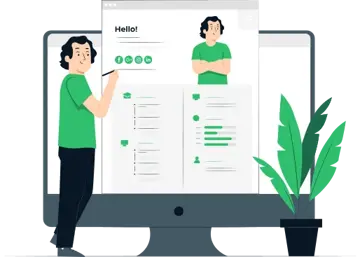
Build your Resume in 15 minutes
Create an awesome resume that meets the expectations of potential employers with our selection of professional, field-tested resume templates.

